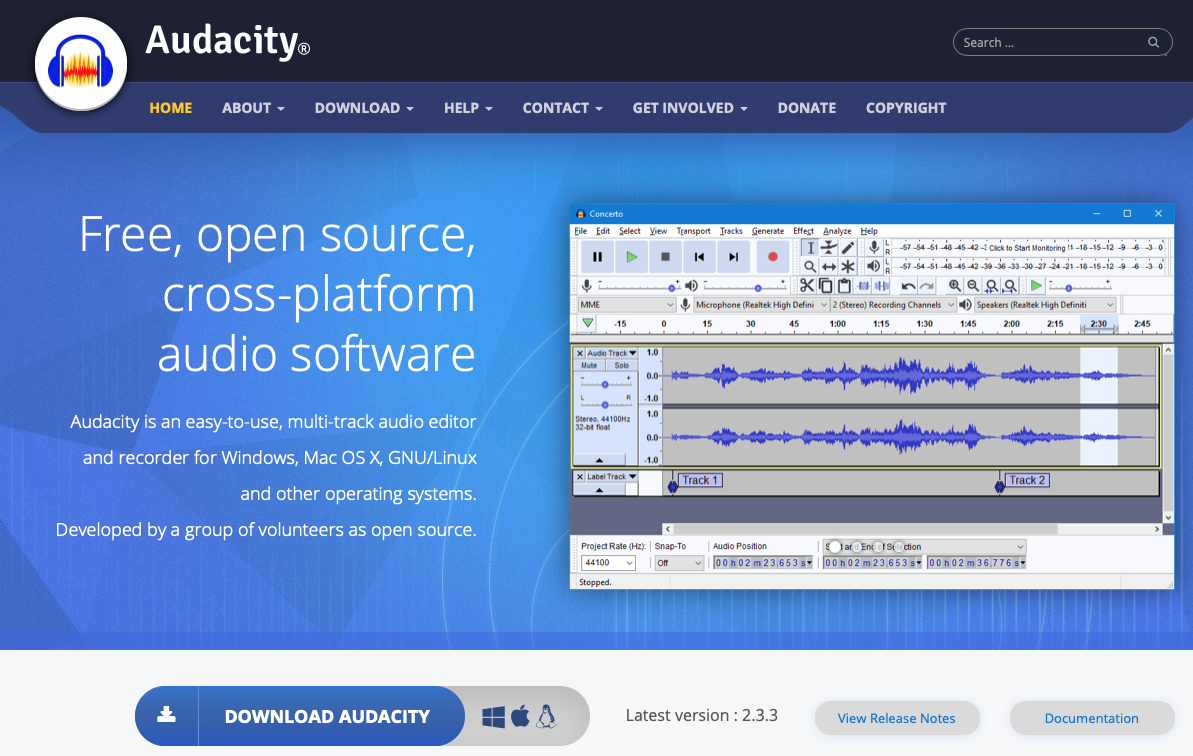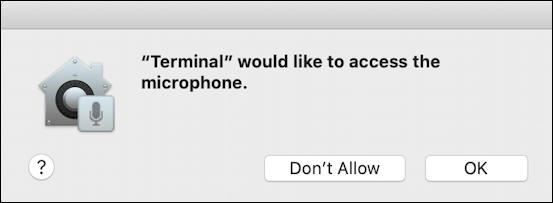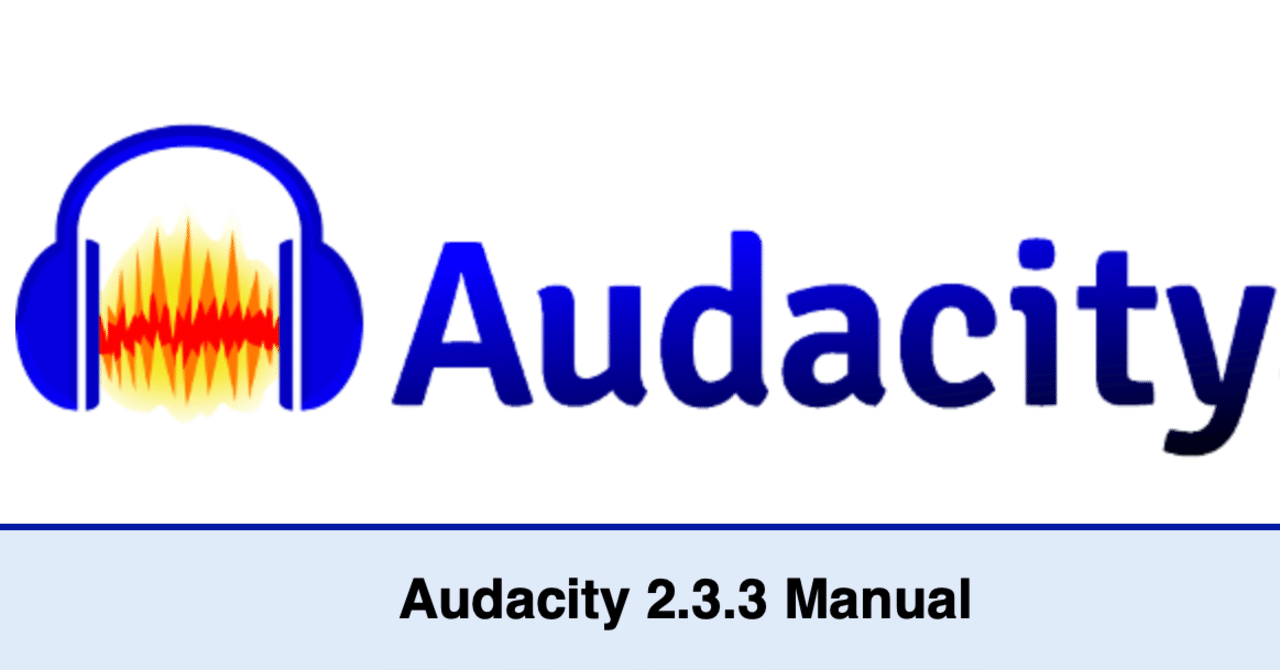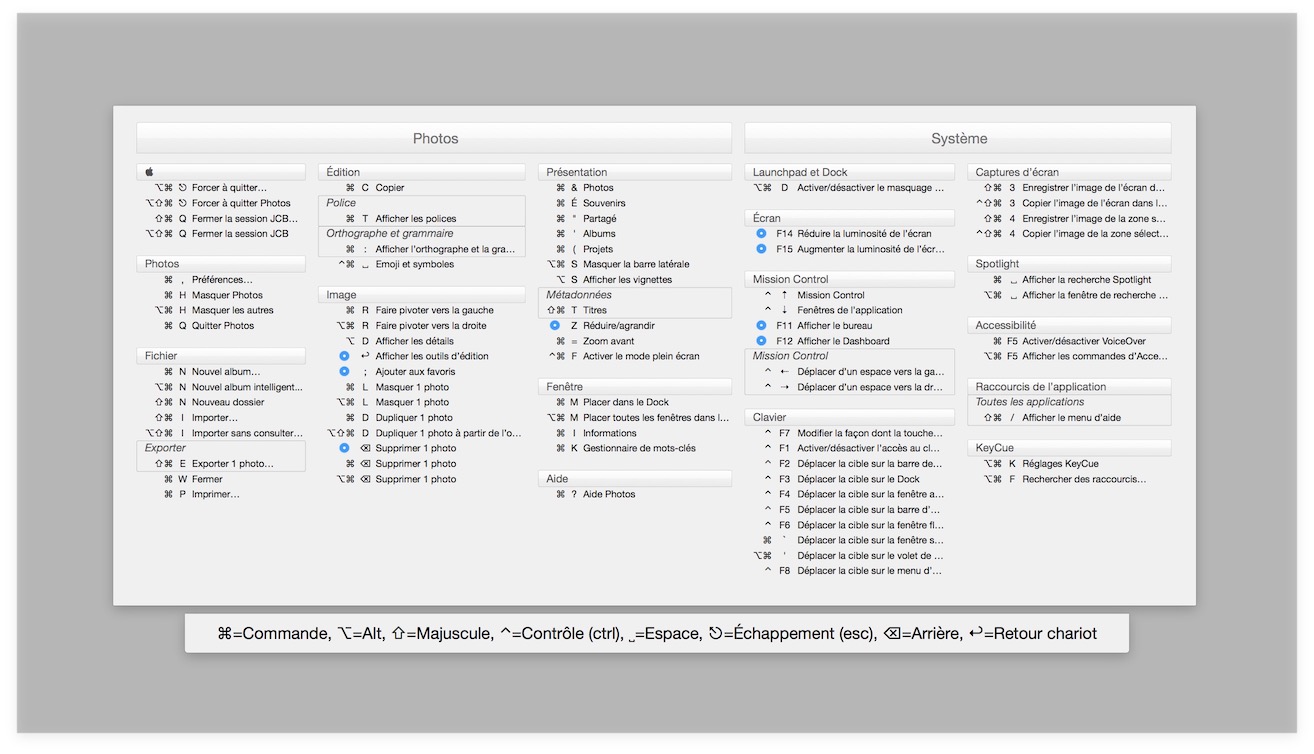Jul 09,2019 • Filed to: Record Audio • Proven solutions
- Audacity and Catalina. Discussion in 'Audio Hardware' started by James H., Dec 2, 2019 at 10:29 AM. Forum Resident Thread Starter. Location: Runnemede, NJ.
- Audacity 2.4 was just released and for those with issues with Mac and Catalina. It is now supported!
(Mac OS 10.13 Catalina users will need to use uTorrent’s web interface instead as the app isn’t 64-bit.). Audacity will turn your Mac into a multi-track recording studio, and it won’t.
Do you want to get a good Audacity reverb ?
Reverb adds echo, sound or noise to your recording with rapid, altered repetitions merged with the novel sound that offers an impression of ambience. The Audacity Reverb outcome bases on the novel 'free verb' process. Additional reverberation is every now and then necessary for concert halls that are too trivial or enclose voluminous people that the hall's normal reverb diminishes.
Adding a small expanse of stereo reverb to a raw mono signal doubled into a two-channel stereo track will frequently make it sound more regular.
Note: that this influence may upsurge the volume, so the 'Dry Gain' should typically be set lower than 0 dB in order to avoid clipping. To permit the influence's reverb tail to be proficient of for hearing, the selection extend further than the end of the audio, which may possibly necessitate adding quietness to the end of the track.
Best Music Downloader, Recorder and Transfer Software You Should Never Miss
iMusic is the best music downloader that works on both Windows and Mac pc. It allows users to download music from over 3000 music sites by copying and pasting the URL of the music. For music played on radio stations, it can help users record the songs and get the music tag and covers automatically . It is a music tool if users really need to download music .
iMusic - Best Audacity Alternative You Deserve to Own
- Download music from Youtube, Vimeo, VEVO, Dailymotion, Spotify or other music sites.
- Download the latest and hottest songs and playlists provided by built-in library.
- Record songs from radio stations and get the identification of the songs, including title, album, genre.
- Transfer music between computer, iTunes library, iphone, ipad, ipod, and Android phones, making it easy for you to share the songs.
- Backup and recover the iTunes Library when it's needed.
- Clean up the dead or broken downloaded music tracks on your iTunes Library .
- 1 click to transfer downloaded music and playlist to USB drive to enjoy in car.
Part 1. How to Set Audacity Reverb
Room Size (%): Sets the size of the computer-generated room. 0% is like a closet, 100% is like a huge church or large lecture hall. A high value will mimic the reverberation result of a large area and a low value will mimic the result of a small room.
Pre-delay (ms): Postpones the commencement of the reverberation for the fixed time subsequently to the start of the original input. It delays the commencement of the reverb tail as well. The maximum pre-delay is 200 milliseconds. Cautious regulation of this parameter can increase the clearness of the result.
Reverberance (%): Sets the interval of the reverberation tail. This regulates how long the reverberation endures for once the original sound being reverbed stop, and so mimics the energy of the room auditory range. For any particular reverberance value, the tail will be bigger for loftier room sizes.
Damping (%): Cumulating the damping creates an added hushed result. The reverberation does not shape up as considerable, and the high frequencies deteriorate quicker than the low frequencies. Mimics the captivation of high frequencies in the reverberation.
Tone Low (%): Adjusting this controller lower than 100% decreases the low frequency constituents of the reverberation, fashioning a lesser amount of roominess as a result.

Tone High (%): Adjusting this controller below 100% decreases the high frequency constituents of the reverberation, producing a lesser amount of perkiness as a result.
Wet Gain (dB): Relates to the volume fine-tuning to the reverberation ('wet') factor in the mix. Accumulating this value in relation to the 'Dry Gain' intensifies the power of the reverb.
Dry Gain (dB): Relates to the volume fine-tuning to the novel ('dry') audio in the mix. Accumulating this value in relation to the 'Wet Gain' decreases the power of the reverb. When the Wet Gain and Dry Gain values are similar, then the combination of wet effect and dry audio to be produced to the track will be made louder or softer by precisely this value (supposing 'Wet Only' is not patterned).
Stereo Width (%): Sets the superficial width of the Reverb outcome for stereophonic tracks only. Growing this value contribute more deviation concerning left and right channels, generating a more roomy result. If set at nil, the result is applied autonomously to left and right channels.
Wet Only: Indicating this regulator, only the wet indicator (additional reverberation) will be in the subsequent output, and the novel audio will be impassive. This can be beneficial when reviewing the result, but in most circumstances, you should uncheck this when adjusting the effect.
Wet Only may be used on the other hand to produce a 'reverb only' track allowing you to be able to then combine in larger or smaller amount with the novel track.
Presets
Click this button to load one of nine fixed presets:
- Vocal I
- Vocal II
- Bathroom
- Small Room Bright
- Small Room Dark
- Medium Room
- Large Room
- Church Hall
- Cathedral
After deciding on the preset that is best suited for what you require, click OK, the settings for the selected preset with be loaded into the effect you want.
User Settings
You are able to save your favorite settings in the Settings0 to Settings9, until you saved your settings in one of these slots, the default settings will load into you effect. Defaults settings are similar to the screenshot above.
Previews
Audacity And Catalina
- Previews what the result would sound like if the current settings are applied.
- Dry Preview: Previews the novel audio selection completely, just like playing that selection in the main window. Comparing the 'Dry Preview' and 'Preview' results reveals a before and after comparison.
Apply a rich and bright reverb to a 'dry' vocal recording.
This technique habits the built-in preset Vocal II. Otherwise, Vocal I creates a softer, less obvious reverb.
Ensure that there is a few seconds of silence at the end of the audio so that the final note can fade away naturally. If necessary, add a few seconds of silence to the end of the track (see steps 1.1 to 1.4 in the example below).
- Select the audio track that contains the vocal recording.
- Click Effect ; Reverb to launch the Reverb effect.
- In the 'Presets' panel, click the Load button, select Vocal II from the list then click OK. The controls will now have been adjusted according to the selected preset.
- Click on the OK button.
Keep the reverb effect on an unconnected track
With this technique, you make an identical the track to apply reverb to, and then apply the Reverb effect to the copied tract track, checking the 'Wet Only' checkbox in the Reverb interchange. You can then regulate the quantity of reverb in the final mixture by fine-tuning the Track Gain Sliders on the reverbed and original track. This offers you the flexibility to twist the fraction of reverb at any time once applying the effect.

1. Add a few seconds of silence to the end of the track:
- Click the Skip to End button on Transport Toolbar or press the shortcut K.
- Click Generate ; Silence.
- Choose how much silence to add (20 seconds is the most you will ever need, 5 second will often be adequate).
- Click OK to add the silence to the end of the track.
2. Select the entire track by clicking on the empty space in the Track Control Panel or use SHIFT + J.
3. Click Edit ; Clip Boundaries ; Join or use its shortcut CTRL + J.
4. Duplicate the track by selecting the track then clicking Edit ; Duplicate.
5. Choose the replica track on its own.
6. Add the Reverb effect to the replica track, ensuring the Wet Only checkbox has the indicated.
7. Play both tracks using the Gain Slider on to blend in an attractive amount of reverb. Make sure the collective improvement is sufficient so that the red snipping indicators at the end of the Playback Meter's replay bars do not come on.
Adding stereo reverb to a mono track
If during the recording the red cursor is only drawing a flat line - an indication of no wavelength, this means that no sound is being recorded.
At times the need persist to enhance reverb to a monophonic track (such as a vocal) but add a stereo range to the reverb. This is commonly more attractive and sounds improved when the ultimate mix is in stereo.

Audacity 2.4.1 Released | Audacity
1. Add a few seconds of silence to the end of the track:
- Add a small number of seconds of silence to the finish of the track (see above).
- Replicate the track by choosing the track then clicking Edit ; Duplicate.
- From the Audio Track Dropdown Menu on the upper track, select Make Stereo Track.
- Select the novel stereo track.
- Add the Reverb effect to the track, selecting an attractive value for 'Stereo Width' and ensuring to uncheck the Wet Only checkbox.
Audacity Gverb with Vocal to Reverb Effects

Instant GVerb settings
If you want to add GVerb straight to your track, here are more or less settings for instantaneous gratification that sound, a lot more improved than the GVerb defaults:
| Features | The Quick Fix | Bright, small hall | Nice hall effect | Singing in the Sewer | Last row of the church | Electric guitar and electric bass |
|---|---|---|---|---|---|---|
| Roomsize | 40㎡ | 50㎡ | 40㎡ | 6㎡ | 200㎡ | 1㎡ |
| Reverb time | 4 s | 1.5 s | 20 s | 15 s | 9 s | one beat |
| Damping | 0.9 | 0.1 | 0.50 | 0.9 | 0.7 | 1 |
| Input bandwidth | 0.75 | 0.75 | 0.75 | 0.1 | 0.8 | 0.7 |
| Dry signal level | 0 dB | -1.5 dB | 0 dB | -10 dB | -20 dB | 0 dB |
| Early reflection level | -22 dB | -10 dB | -10 dB | -10 dB | -15 dB | -15 dB |
| Tail level | -28 dB | -20 dB | -30 dB | -10 dB | -8 dB | 0 dB |
The amount of time for one beat of the song. For example, a beat in a 151 beats-per-minute song is 0.397351 seconds.
Step 1: Start with a text to speech program
Audacity Not Recording On Mac
First, you need to adapt text to voice. Unquestionably, you could do your own soundtracks, but robots do not start with humanoid sounds. They commence with computer sounds. Change the opinion to 'Mike, US English.'
Now add the conversation you want your robot to say.
Step 2: Use Audacity to create your robot voice!
Open up Audacity, and use the File menu to select 'Open.' Navigate to the file you just saved and then open it.
During the following steps you will must ensure that, the complete audio file is carefully chosen by pressing CTRL+A.
- Select the complete audio file. Use CTRL+A .
- Click on 'Effect' in the menu bar, and chose 'Change Pitch...'.
- Alter the pitch -14%, and click OK.
- In the Effect menu, select 'Echo'.
- Modify 'Delay time' to .015 and 'Decay Factor' to .65. Click OK.
- Once more in the Effect menu, select 'Change Tempo...'.
- Reduce the tempo by 10% (-10.000) and click OK.
- Recap steps 4 and 5.
Now play your robot voice with the green 'Play' button toward the top.
Click on 'File' and then 'Export as WAV...' and save it.

Aug 27,2019 • Filed to: Record Audio • Proven solutions
Is there a way to get free music in our pocket without any illegal procedures but with persistent internet connection? One such method is to record freely an available audio directly from YouTube by using an audio-editing software. One of such free and easy-to-use software solutions is audacity. The use of this technique is for all kinds of video. The process is quite simple and highly efficient so without further ado, let's get started with the tutorial on how to record audio directly from YouTube with Audacity.
Part 1. How to Record Audio from YouTube with Audacity
Follow these easy steps:
Audacity Cannot Record With RME Babyface Pro Fs And Catalina ...
- Step 1: First things first, you'll need to have an audacity installed on your personal computer. You can download the software for free from its official website http://audacity.sourceforge.net/, then install it. Once you're done with the setup, we're ready to start recording!
- Step 2: Open audacity and start by configuring the program to record audio right from your computer. To do this, go to the menu bar, select Edit and then click on the preferences section.
- Step 3: This will open a new window with a number of options for configuring your sound settings. First, go to the Devices section which is most likely to be on top of the table of options. In the preference options for devices, look for the recording section.
- Step 4: Under the recording section, you'll find options for configuring interface, playback and recording. Here, you need to configure your device for recording audio by going to devices and from the drop down menu, select the option stereo mix. Remember to set the channel to stereo by selecting the option 2 (stereo) from the second drop down menu. Save the changes and close the window by clicking on OK.
- Step 5: Now it's time to open the YouTube video you want to record the audio from. It is suggested that you load the video fully before beginning the recording process. Open the page of the video you're interested in, click on the play button (if it doesn't start playing automatically) and then press pause button to let the video load without playing it. You can do this before beginning the configuration process, especially if you have a slower internet connection.
- Step 6: Once you're done with the setting up stage, you can begin the actual recording process. To do this, click the record button on audacity, which is a red dot at the top of the window. As soon as you do this, go to YouTube and start playing the segment of the video (part or full) you want to record the audio of. After recording the segment of the sound you wanted, click on the Stop button (brown square) in audacity.
- Step 7: Now that your recording is over, it's time to export the file to an audio format, preferably mp3. To do this, click on file and select the export option. From the drop-down menu, select mp3 files. Just enter a file name and click on save.
- It automatically filters out the ads in between tracks.
- There's no loss in the quality of the audio you record.
- It automatically identifies the songs and gathers information about the track.
- It automatically transfers your recorded music to your iTunes library.
That’s it! Your recording is complete.
Now your recording is a portable mp3 file which you can play on any multimedia platform.
Part 2. How to Record Audio or Music without Noise
Here are some problems and solutions for troubleshooting:
1. I cannot find the option for stereo mix under devices.
This usually happens when stereo mix is disabled. To enable it, go to control panel> hardware and sound>sound. In the sound window, click on the recording tab, right click in a blank space within the tab, choose show disabled devices from the menu that appears. The stereo mix device will now be visible. Right click the device and select the enable option.
2. I still cannot find the stereo mix option.
In this case, your PC has an integrated sound card which does not allow you to record from a streaming YouTube video. However, you can still use many online services to get the same results.
3. I'm being unable to encode my files to mp3.
In saving your file in mp3 format, you need to download LAME extension from its download site, lame.buanzo.org or lame.sourceforge.net then install it. You can then proceed to exporting the files to mp3 format. You may be asked for the location of the LAME file. Navigate to the file lame_enc.dll which is likely to be in the directory you installed the LAME file to. Once you're done with this, you should have no trouble converting your files to mp3.
Part 3. Record YouTube with Audacity Alternative
If you're a mac user or someone who doesn't find using audacity tedious, one handy alternative is the iMusic. You can use this software to record live streaming audio. It is available on its site www.iskysoft.com/audio-recorder-mac/. The full version of this softare costs about $29, but it will provide you with a number of features that audacity doesn't.
iMusic - Record YouTube with Audacity Alternative
How to record audio from Youtube using Audacity alternative
Step1. Install and open iMusic. After then, click 'GET MUSIC'. There are 3 options for you: Discover music with the built-in music library, Download music by copy-n-paste the song URL, and Record music. Here, you need to click 'Record'.
Step2. Click on the red record button. Play the audio you wish to record either with desktop software, web browser or any other music player. Note that the recording doesn't begin unless you start playing the audio track.
Step3. Go to library, right click the track and select identify track info. Your audio track has been saved.
These are the methods you could employ to save audio from YouTube. However, make sure you don't misuse them to avoid troubles. Undoubtedly, these great tools will greatly reduce the gap between you and your music.
